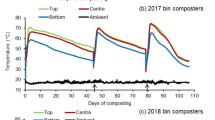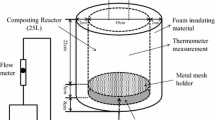Abstract
As a result of bovine spongiform encephalopathy in Canada, specific tissues at risk of harbouring prions are not allowed to enter the food chain. Composting may be a viable alternative to rendering and land filling for the disposal of specified risk material (SRM). Two types of laboratory-scale composters, actively-heated and ambient systems were constructed to assess the biodegradation of SRM over 30 days. A second heating cycle was generated by mixing the compost after 15 days. Compared to ambient composters, temperature profiles in actively-heated composters were above 50°C for 5 and 4 days longer in the first and second composting cycles, respectively. Degradation of SRM was similar between two composter types during two composting cycles, averaging 52.2% in the first cycle and 43.9% in second cycle. Denaturing gradient gel electrophoresis (DGGE) revealed that changes in the actinobacteria populations in the first composting cycle were of a temporal nature, whereas alterations in populations in the second composting cycle were more related to active heating of compost. Sequencing of the dominant DGGE bands showed the predominance of Corynebacterium, Promicromonospora, Pseudonocardia, and Thermobifida in the first composting cycle and Corynebacterium, Mycobacterium, Nocardia, Saccharomonospora, and Streptomyces in the second composting cycle. Active heating can alter the nature of actinobacteria populations in compost, but does not appear to have a major impact on the extent of degradation of SRM.






Similar content being viewed by others
References
Ahn HK, Richard TL, Glanville TD (2008) Optimum moisture levels for biodegradation of mortality composting envelope materials. Waste Manag 28:1411–1416
Al-Musallam AA, Al-Zarban SS, Fasasi YA, Kroppenstedt RM, Stackebrandt E (2003) Amycolatopsis keratiniphila sp. nov., a novel keratinolytic soil actinomycete from Kuwait. Int J Syst Evol Microbiol 53:871–874
Al-Zarban SS, Al-Musallam AA, Abbas I, Stackebrandt E, Kroppenstedt RM (2002) Saccharomonospora halophila sp. nov., a novel halophilic actinomycete isolated from marsh soil in Kuwait. Int J Syst Evol Microbiol 52:555–558
Applied Biosystems (2005) Applied Biosystems Sequence Scanner Software v1.0 Read Me. Applied Biosystems, Foster City. http://www.appliedbiosystems.com/support/software/sequencescanner/ReadMe.htm
Applied Maths Inc. (2007) BioNumerics QuickGuide version 5.1. Applied Maths Inc., Austin
Beck-Friis B, Smårs S, Jönsson H, Kirchmann H (2001) Gaseous emissions of carbon dioxide, ammonia and nitrous oxide from organic household waste in a compost reactor under different temperature regimes. J Agric Eng Res 78(4):423–430
Berge AB, Glanville TD, Millner PD, Klingborg DJ (2009) Methods and microbial risks associated with composting of animal carcasses in the United States. JAVMA 234:47–56
Boon NW, De Windt W, Verstraete W, Top EM (2002) Evaluation of nested PCR-DGGE (denaturing gradient gel electrophoresis) with group-specific 16S rRNA primers for the analysis of bacterial communities from different wastewater treatment plants. FEMS Microbiol Ecol 39:101–102
Campbell CD, Darbyshire JF, Anderson JG (1990a) The composting of tree bark in small reactors: self-heating experiments. Biol Wastes 31:145–161
Campbell CD, Darbyshire JF, Anderson JG (1990b) The composting of tree bark in small reactors: adiabatic and fixed-temperature experiments. Biol Wastes 31:175–185
Ceustermans A, De Cercq D, Aertsen A, Michiels C, Coosemans J, Ryckeboer J (2007) Inactivation of Salmonella Senftenberg strain W775 during composting of biowastes and garden wastes. J Appl Microbiol 103:53–64
CFIA (2008) Meat hygiene manual of procedures. Chapter 4: Inspection procedures, dispositions, monitoring and controls—Annex N, removal of specified risk materials (SRM) from cattle slaughtered in establishments inspected under the meat inspection regulations, 1990. http://www.inspection.gc.ca/english/fssa/meavia/man/ch4/annexne.shtml. Accessed 19 Oct 2010
Ekinci K, Keener HM, Michel FC, Elwell DL (2004) Modeling composting rate as a function of temperature and initial moisture content. Compost Sci Util 12:356–364
Felsenstein J (2005) PHYLIP (phylogeny inference package) version 3.6. Distributed by the author. Department of Genome Science, University of Washington, Seattle
Hao X, Chang C, Larney FJ, Travis GR (2001) Greenhouse gas emissions during cattle feedlot manure composting. J Environ Qual 30:376–386
Heuer H, Krsek M, Baker P, Smalla K, Wellington EMH (1997) Analysis of actinomycete communities by specific amplification of genes encoding 16S rRNA and gel-electrophoretic separation in denaturing gradients. Appl Environ Microbiol 63:3233–3241
Hogan JA, Miller FC, Finstein MS (1989) Physical modeling of the composting ecosystem. Appl Environ Microbiol 55:1082–1092
Huang J, Wang C, Jih C (2000) Empirical model and kinetic behaviour of thermophilic composting of vegetables waste. J Environ Eng 126:1019–1025
Hui Z, Doi H, Kanouchi H, Matsuura Y, Mohri S, Nonomura Y, Oka T (2004) Alkaline serine protease produced by Streptomyces sp. degrades PrP(Sc). Biochem Biophys Res Commun 321:45–50
Inbar Y, Hadar Y, Chen Y (1993) Recycling of cattle manure: the composting process and characterization of maturity. J Environ Qual 22:857–863
Kalbasi A, Mukhta S, Hawkins SE, Auvermann BW (2005) Carcass composting for management of farm mortalities: a review. Compost Sci Util 13:180–193
Krogmann U, Körner I (2000) Technology and strategies of composting. In: Klein J, Winter J (eds) Biotechnology: a multi-volume comprehensive treatise, vol 11c, 2nd edn. Wiley-VCH, Weinheim, Germany, pp 127–150
Lacey J (1997) Actinomycetes in composts. Ann Agric Environ Med 4:113–121
Larney FJ, Olson AF (2006) Windrow temperature and chemical properties during active and passive aeration composting of beef cattle feedlot manure. Can Soil Sci 86:783–797
Manios T, Maniadakis K, Kalogeraki M, Mari E, Stratakis E, Terzakis S, Boytzakis P, Naziridis Y, Zampetakis L (2006) Efforts to explain and control the prolonged thermophilic period in two-phase olive oil mill sludge composting. Biodegradation 17:285–292
Mason IG, Milke MW (2005) Physical modelling of the composting environment: a review. Part 1: reactor systems. Waste Manag 25:481–500
McCrory DF, Hobbs PJ (2002) Additives to reduce ammonia and odor emissions from livestock wastes: a review. J Environ Qual 30:345–355
Mitsuiki S, Takasugi M, Moriyama Y, Futagami T, Goto M, Kanouchi H, Oka T (2010) Identification of an alkaliphilic actinomycetes that produces a PrPSc-degrading enzyme. Ann Microbiol 60:349–353
Page RDM (2001) Tree view. Distributed by the author. Faculty of Biomedical and Life Sciences, University of Glasgow, Glasgow. http://taxonomy.zoology.gla.ac.uk/rod/treeview.html
Phillips LA, Greer CW, Germida JJ (2006) Culture-based and culture-independent assessment of the impact of mixed and single plant treatments on rhizosphere microbial communities in hydrocarbon contaminated flare-pit soil. Soil Biol Biochem 38:2823–2833
Puhl AA, Selinger LB, McAllister TA, Inglis GD (2009) Actinomadura keratinilytica sp. nov., a keratin-degrading actinobacterium isolated from bovine manure compost. Int J Syst Evol Microbiol 59:828–834
Qdais HA, Hamoda MF (2004) Enhancement of carbon and nitrogen transformations during composting of municipal solid waste. J Environ Sci Health 39(2):409–420
Ros M, Klammer S, Knapp B, Aicherger K, Insam H (2006) Long term effects of compost amendment of soil on functional and structural diversity and microbial activity. Soil Use Manage 22:209–218
Ryckeboer J, Mergaert J, Vaes K, Klammer S, De Clercq D, Coosemans J, Insam H, Swings J (2003) A survey of bacteria and fungi occurring during composting and self-heating processes. Ann Microbiol 53:349–410
Rynk R (1992) On-farm composting handbook. Natural Resource, Agriculture and Engineering Service, Ithaca
SAS Institute (2001) SAS/STAT user’s guide, version 8. SAS Institute Inc., Cary
Schwarzlose I, Gerdes U, Gerlach GF, Runge M, Thalmann G, Nöckler A, Klarmann D, Behr KP, Neumann U, Seedorf J, Hartung J, Jeske C (2008) Composting of poultry carcasses as an alternative method for disposal in case of an outbreak of an epizootic disease: fist results. Dtsch Tierarztl Wochenschr 115:150–157
Siddique T, Okeke BC, Zhang Y, Arshad M, Han SK, Frankenberger WT (2005) Bacterial diversity in selenium reduction of agricultural drainage water amended with rice straw. J Environ Qual 34:217–226
Smårs S, Beck-Friis B, Jönsson H, Kirchmann H (2001) An advanced experimental composting reactor for systematic simulation studies. J Agric Eng Res 78:415–422
Stanford K, Nelson V, Sexton B, McAllister TA, Hao X, Larney FJ (2007) Open-air windrows for winter disposal of frozen cattle mortalities: effects of ambient temperature and mortality layering. Compost Sci Util 15:257–266
Stanford K, Hao X, Xu S, McAllister TA, Larney F, Leonard JJ (2009) Effects of age of cattle turning technology and compost environment on disappearance of bone from mortality compost. Bioresour Technol 100:4417–4422
Steger K, Jarvis Å, Vasara T, Romantschuk M, Sundh I (2007a) Effects of differing temperature management on development of Actinobacteria populations during composting. Res Microbiol 158:617–624
Steger K, Sjögren ÅM, Jarvis Å, Jansson JK, Sundh I (2007b) Development of compost maturity and Actinobacteria population during full-scale composting of organic household waste. J Appl Microbiol 103:487–498
Strom PF (1985) Identification of thermophilic bacteria in solid waste composting. Appl Environ Microbiol 50:906–913
Van Herk FH, Cockwill CL, Guselle N, Larney FJ, Olson ME, McAllister TA (2004) Elimination of Giardia cysts and Cryptosporidium oocysts in beef feedlot manure compost. Compost Sci Util 12:235–241
Vasileva-Tonkova E, Gousterova A, Neshev G (2009) Ecologically safe method for improved feather wastes biodegradation. Int Biodeterior Biodegrad 63:1008–1012
Wilkinson KG (2007) The biosecurity of on-farm mortality composting. J Appl Microbiol 102:609–618
Xu S, Hao X, Stanford S, McAllister TA, Larney FJ, Wang J (2007) Greenhouse gas emissions during co-composting of cattle mortalities with manure. Nutr Cycl Agroecosyst 78:177–187
Xu W, Reuter T, Inglis GD, Larney FJ, Alexander TW, Guan J, Stanford K, Xu Y, McAllister TA (2009) A biosecure composting system for disposal of cattle carcasses and manure following infectious disease outbreak. J Environ Qual 38:437–450
Xu S, McAllister TA, Leonard JJ, Clark OG, Belosevic M (2010) Assessment of the microbial communities involved in the decomposition of specified risk material using a passively aerated laboratory-scale composter. Compost Sci Util 18:255–265
Acknowledgments
This project was conducted with funding from the Prion Inactivation and Environment project, from the Alberta Prion Research Institute and the Specified Risk Material Disposal Program of Agriculture and Agri-Food Canada. The technical assistance of F. Van Herk, B. Baker, S. Cook, L. Selinger, and W. Smart are much appreciated. Direction from Reive Pumping and Heating Ltd. in Lethbridge with regard to the design and construction of the water circulation piping system was also invaluable. The authors also acknowledge Ben’s Meat in Lethbridge for the supply of bovine brain tissue from cattle under 30 months of age.
Author information
Authors and Affiliations
Corresponding author
Rights and permissions
About this article
Cite this article
Xu, S., Douglas Inglis, G., Reuter, T. et al. Biodegradation of specified risk material and characterization of actinobacterial communities in laboratory-scale composters. Biodegradation 22, 1029–1043 (2011). https://doi.org/10.1007/s10532-011-9461-5
Received:
Accepted:
Published:
Issue Date:
DOI: https://doi.org/10.1007/s10532-011-9461-5




